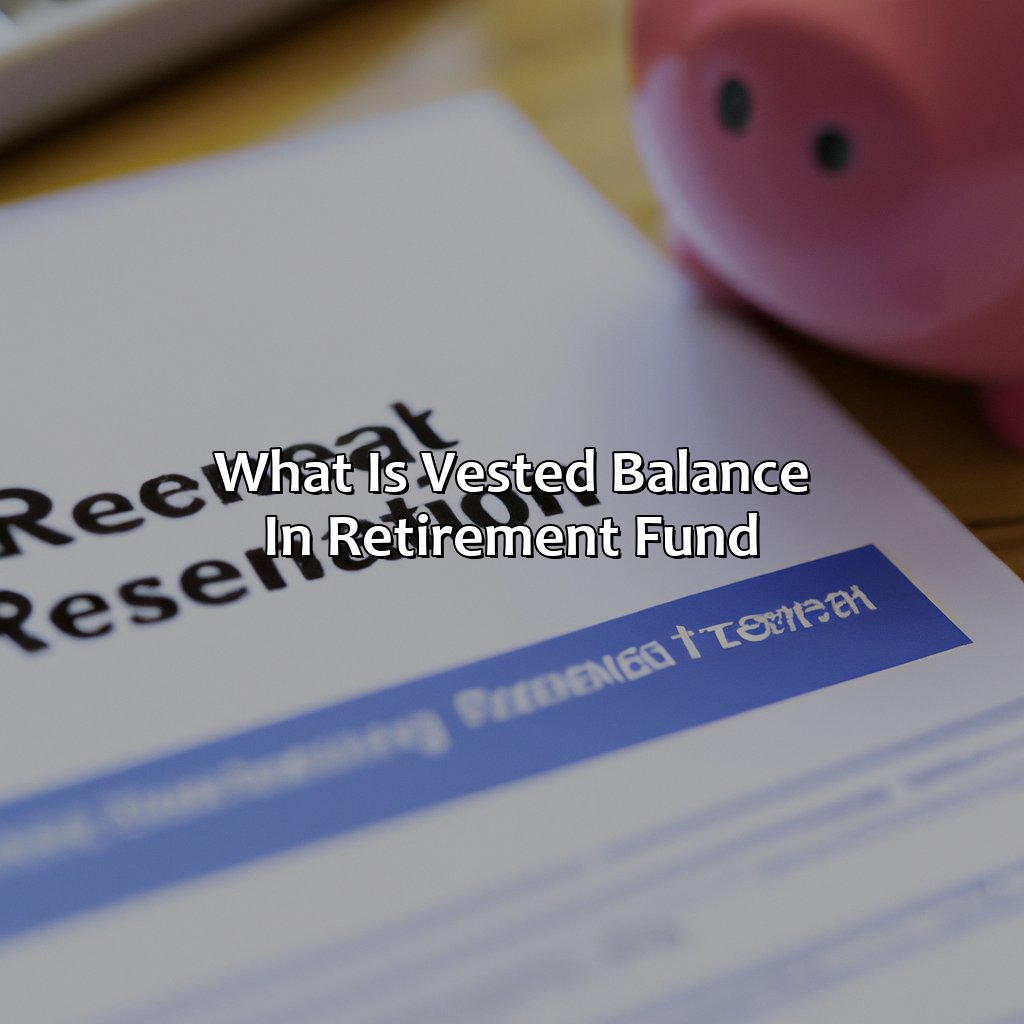What Is Vested Balance In Retirement Fund?
Key Takeaway:
- Vested balance in retirement fund is the portion of the account balance that belongs to the employee and is fully owned by them, regardless of their employment status. This means that even if the employee leaves the company, they are still entitled to the vested balance in their retirement fund.
- The vesting period determines the amount of time an employee must work for the employer before they become fully vested in their retirement fund. This period can vary depending on the employer’s retirement plan.
- Knowing and understanding the difference between vested and non-vested balances is important for employees to make informed decisions about their retirement and to properly plan for their financial future.
Are you wondering what a vested balance in a retirement fund is? This article will give you all the information you need to understand this important concept and plan your retirement with confidence. You’ll understand the benefits of vested balances and the potential impact they have on your retirement funds.
Understanding Vested Balance in Retirement Fund
In the world of retirement planning, it is essential to have a comprehensive understanding of the Vested Balance in your Retirement Fund. This balance represents the portion of your retirement savings that you are entitled to keep, even if you were to leave your current employer. The calculation of the Vested Balance is based on the amount of time you have spent with the employer and the specific vesting schedule in place.
It is crucial to note that the Vesting Schedule may differ between companies, and some employers have specific requirements before an employee can become fully vested. Once the Vested Balance is determined, it is important to consider how it fits into your overall retirement planning strategy.
It is worth noting that Retirement Fund contribution fees can vary, and in some cases, fees may be higher than others. The US Department of Labor indicates that fees of just 1% can consume as much as 28% of a participant’s retirement savings over time. Therefore, it is essential to be aware of the fee structure of your Retirement Fund.
According to a report published by Forbes, the average 401(k) plan has roughly 17 investment options to choose from. Knowing the fees, funds, and balances of your Retirement Fund can help you make more informed decisions, increasing your chances of achieving your retirement goals.
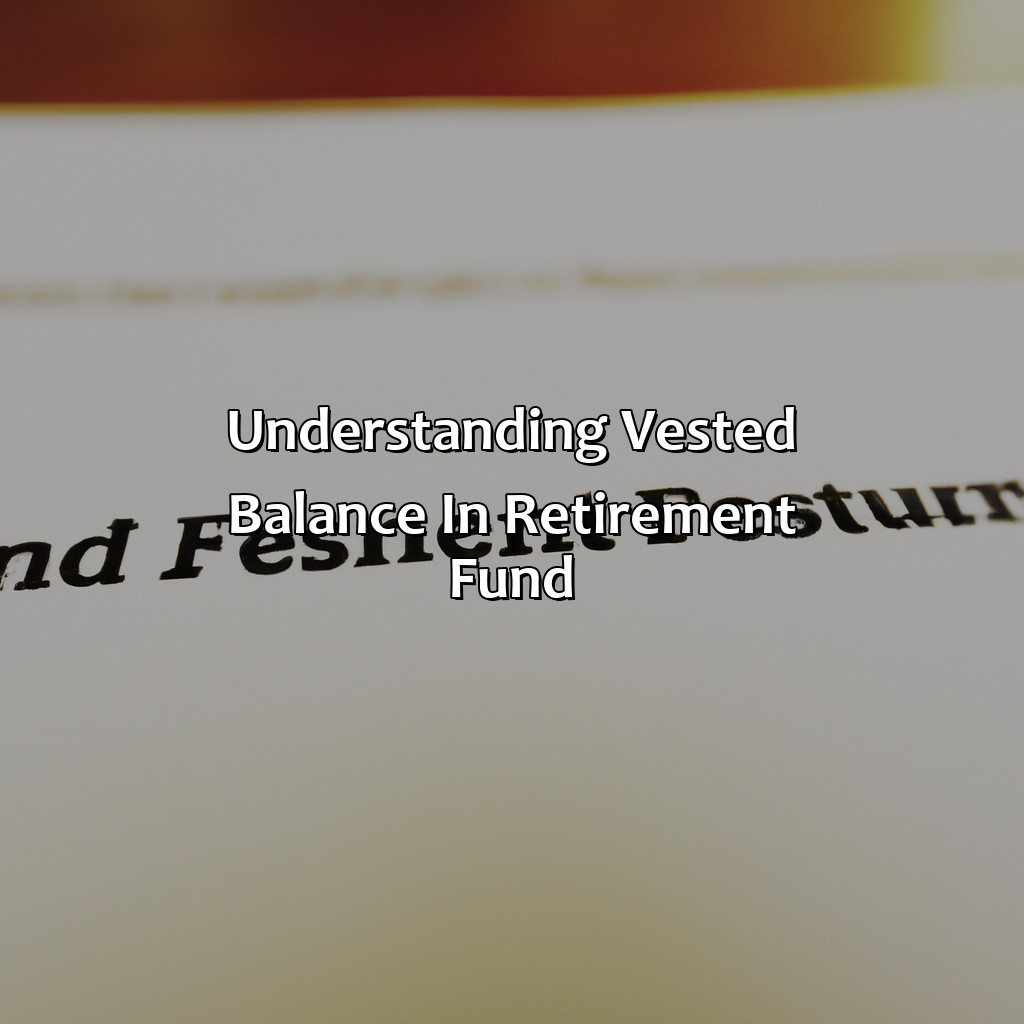
Image credits: retiregenz.com by David Woodhock
What is Vested Balance?
Want to comprehend vested balance in your retirement fund? You’ve come to the right place! Vested balance has a definition plus various types. These will help you identify and understand how they affect your retirement account. Take the plunge to gain more knowledge!
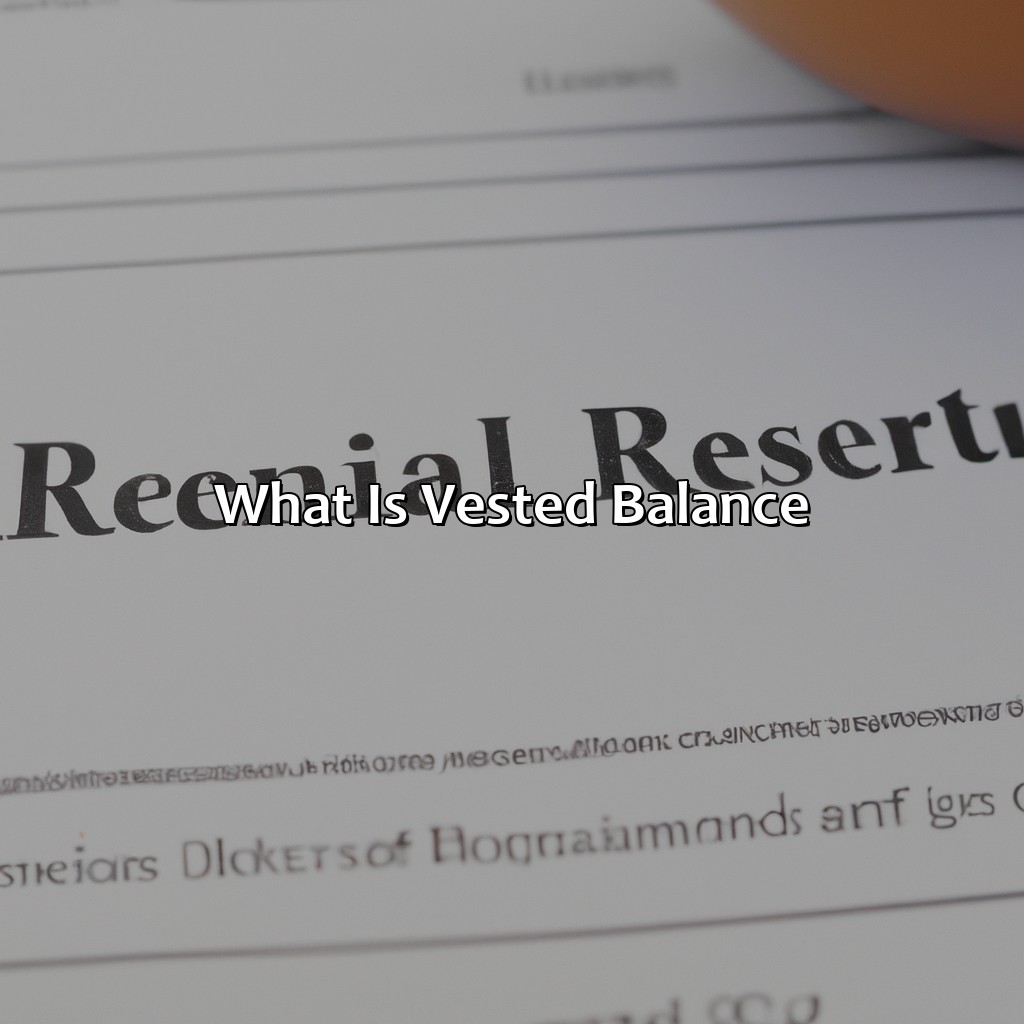
Image credits: retiregenz.com by Joel Washington
Definition of Vested Balance
Vested balance refers to the portion of a retirement fund that is fully owned by an employee. It is the amount of money contributed by an employer that belongs solely to the employee, regardless of whether they stay with the company or leave. This means that if an employee terminates their employment, they are entitled to receive the vested balance immediately without losing any of it.
The vesting schedule varies from employer to employer and can range anywhere between immediate vesting and a gradual vesting over several years. For instance, in a five-year graded schedule, 20% of the employer contributions will become vested after working for one year, 40% after two years, and so on until 100% vested after five years.
It is essential for employees to keep track of their vested balance as it determines how much money they can withdraw or roll over into another retirement account when they leave their job. Moreover, if an employee has multiple jobs with different retirement plans, understanding their vested balance helps them plan better for their future.
Pro Tip: It’s always advisable to read your employers’ retirement plan documents thoroughly and pay attention to the vesting schedule mentioned there. Understanding your vested balance can help you make informed decisions about managing your retirement savings effectively.
Vested balance comes in all shapes and sizes, just like your retirement plans (or lack thereof).
Types of Vested Balance
Vested Balance is a critical retirement concept that pays dividends in the future. In this section, we will explore various forms of vested balance and their significance.
| Types of Vested Balance | Description |
|---|---|
| Cliff Vesting | All benefits vest at once after a set number of years. |
| Graded Vesting | Benefits vest gradually over time based on specific schedules. |
| Immediate Vesting | All benefits are fully vested from the start of the employment. |
It’s worth noting that employer contributions to 401(k) plans can differ depending on vesting schedules. Therefore, it’s essential to understand what vested balance option your plan offers and how it affects your long-term financial health.
To have a successful retirement plan, knowing different types of vested balances is crucial for making informed decisions about investment allocations. Make sure to examine your plan’s documentation to learn more about the available benefits and how each one affects your portfolio.
Don’t miss out on financial opportunities for a better future! Stay informed about vested balance options and leverage them towards achieving your financial goals.
Calculating vested balance is like trying to solve a Rubik’s cube blindfolded – complicated, frustrating, and you just hope it ends up in your favor.
How is Vested Balance Calculated?
Accurate vested balance calculation for your retirement fund? Consider essential factors! Two methods to calculate? Here we discuss. Factors affecting the calculation? Read on to find out!
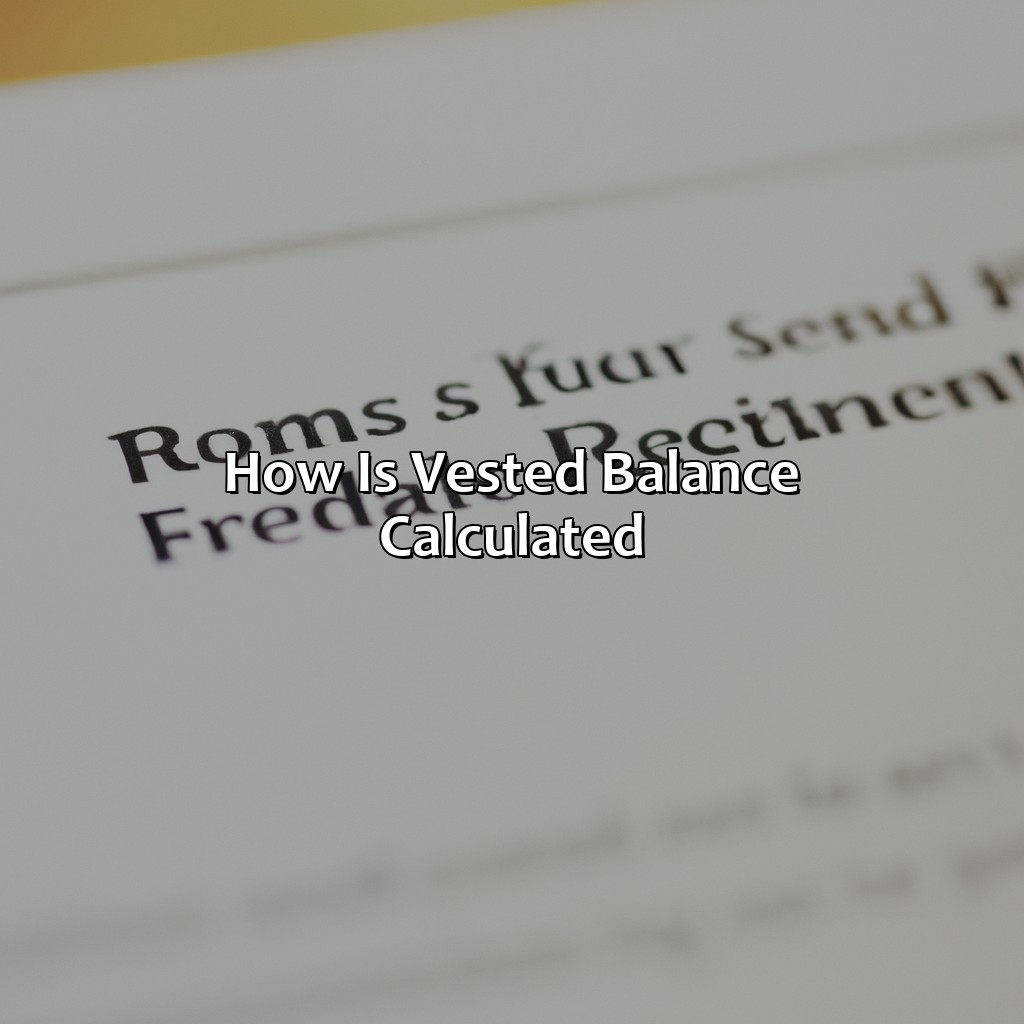
Image credits: retiregenz.com by James Arnold
Methods to Calculate Vested Balance
To understand the process of calculating the vested balance in retirement funds, there are various methods one can follow. These methods depend on different factors such as contributions, earnings and years of service.
Here is a 4-Step Guide on Methods to Calculate Vested Balance:
- Determine when vested status is attained
- Calculate total contributions made by both employee and employer
- Calculate investment earnings based on vesting schedule(s)
- Sum up the vested portions for employee and employer contributions and investment earnings
It is important to note that some pension plans may employ other formulas for calculating vested benefits. Employees should familiarize themselves with the terms of their respective plan so that they can understand what formula applies.
When calculating vested balances, employees need to take into consideration factors such as employee contribution rate, employer contribution rate as well as how long the employee has been employed. Additionally, vesting schedules differ between plans. It is thus imperative for employees to consult their respective plan’s summary plan description or consult with human resources experts in order to make informed decisions regarding planning for retirement.
An interesting history about this subject matter can be traced back as early as 1918 when American Express introduced a retirement savings program aimed at providing financial security to its retired employees. Other employers soon followed suit in adopting different retirement programs tailored towards ensuring a better life after retirement.
The vested balance calculation is like a game of Jenga, one wrong move and the whole thing comes tumbling down.
Factors Affecting Vested Balance Calculation
Factors that influence the calculation of retirement funds depend on several elements that impact the vested balance. The vesting schedule varies from one employer to another, affecting how much money employees have access to when they leave their job or retire.
Below is a table representing examples of factors affecting the calculation of vested balance in a retirement fund:
| Factors Affecting Vested Balance | |
|---|---|
| Length of Employment | Vesting Schedule |
| Age at Which Employees Start Participating | Type of Plan |
| Job Termination Reason | Employer Contributions |
It’s important to note that some plans allow for immediate vesting, while others require specific employee contributions or match employer contributions over time. These factors impact how much an employee can withdraw from their plan and what percentage is considered vested.
Consideration should be given to whether certain types of employment termination affect an employee’s access to funds by examining an individual plan’s rules. For instance, if someone is laid off or fired, they might have various restrictions on withdrawal based on their plan design.
According to history, employer-sponsored pension plans began in the early 20th century as companies looked for ways to retain talented workers long-term. Companies started offering pension benefits as a means of keeping their employees loyal and committed; this contributed significantly to the rise in retirement accounts.
Don’t vest your retirement plans in anyone but yourself – your vested balance is your golden ticket to a happy retirement.
Why is Vested Balance Important?
Gaining insight into why vested balance in retirement funds is significant? It’s helpful to both employees and employers. Let’s investigate the perks of vested balance; one for employees and one for employers.
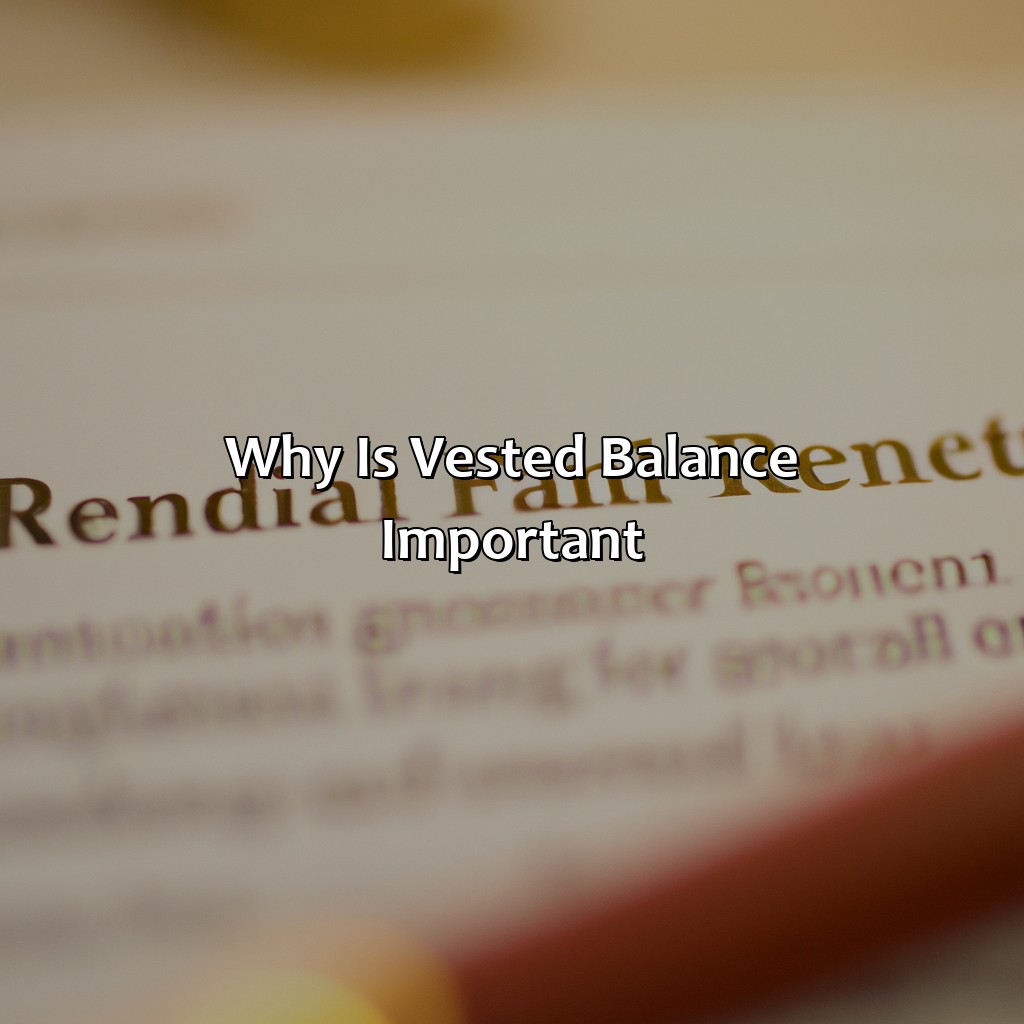
Image credits: retiregenz.com by Adam Woodhock
Benefits of Vested Balance to Employees
One of the most significant advantages that vested balance provides employees is financial security for retirement. Employees with vested accruement have irrevocable rights to their employer’s contributions to their retirement plans. This means that if an employee leaves the company or retires, they will still receive the funds they have vested in their retirement account.
Benefits of Vested Balance to Employees:
- Guaranteed Retirement Savings: Knowing that accrued contributions are theirs can alleviate financial concerns related to retirement.
- Flexibility: Since employers cannot take back contributions, employees have more freedom with job mobility and retirement planning.
- Incentive to Stay: Often, pension plans require a certain amount of service time before becoming fully vested. This can discourage skilled workers from leaving and increase worker retention rates.
- Tax Advantages: Contributions and associated interests are not taxed until withdrawal time, which is usually in retirement when the tax rate is lower.
It’s worth noting that while vesting schedules stipulate the length of service required before an employee has full ownership of accrued benefits, such schedules vary between companies and countries.
Years ago, one employee left her employer after three years but announced at a board meeting months later that she had left her job because they didn’t offer a retirement plan with vesting options. She landed at another company with such provisions and eventually became fully vested after several years before retiring. Her story underlines how important investing early can be when it comes to securing primary commitments for future life stages like comfortable retirements.
Employers love vested balances more than cats love laser pointers – it’s a win-win situation for both parties.
Benefits of Vested Balance to Employers
Employer Gains of Vested Balance in Retirement Investments
Vested balance is critical to employers as it provides them benefits that ultimately help them boost their employees’ morale and performance. Here are some gains for Employers:
- Retention Of Employees: Providing different retirement plans, including vesting schedules keeps the employees loyal which leads to retention of staff. Retaining the current workforce allows companies to save on recruitment costs while avoiding the knowledge drain that goes with losing workers.
- Tax Benefits: Vesting schedules allow for tax benefits to the employer when it comes to matching contributions made by employees since any monies returned due to an employee leaving before becoming fully vested reduce tax liabilities.
- Budget Planning: An employer can determine how much money goes towards employee benefits such as 401(k) plans with a pre-set vesting schedule. This helps establish a budget and structure cash flow that is used for other expenses like salaries, rent or supplies needed without worrying about setting aside all funds at one time.
One key point worth noting is that having competitive retirement plan options attracts more staff applicants who intend on staying long-term.
Story time: My friend who previously worked at a company experienced first-hand how employers benefit from vested balance. The company had an impressive retirement investment plan which they offered all of their employees, and this led to high rates of job satisfaction and near-zero employee turnovers. As per my friend’s observation, this initiative helped elevate performance levels and, as a result, driving high profits for the company in question.
Your non-vested balance is like a cake that’s still in the oven – it’s not quite ready yet, but the government already wants a slice.
Vested Balance vs. Non-Vested Balance
Know the diff between Vested Balance and Non-Vested Balance. It’s important to understand how much of your retirement savings is secure and how much is not. Here’s the key distinctions between them. It’ll help you figure out why it’s so crucial to know the difference.
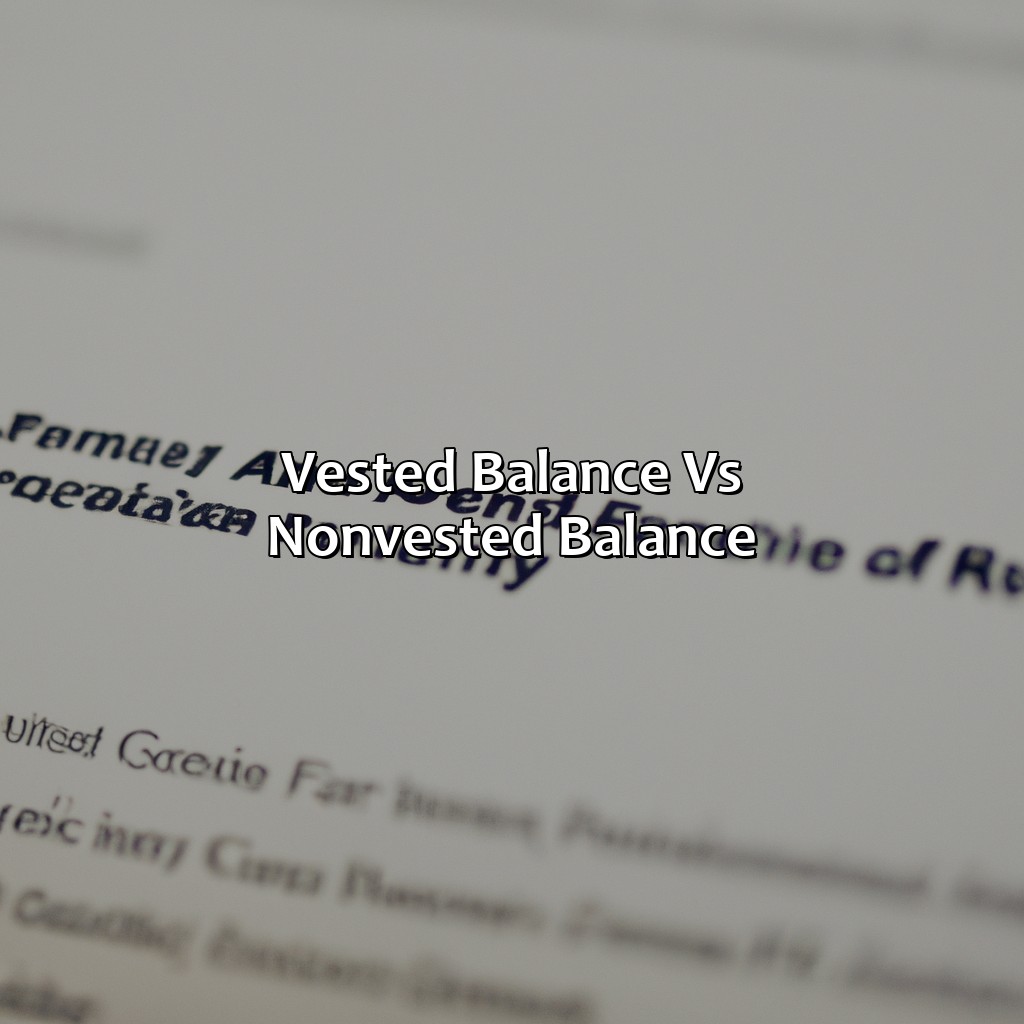
Image credits: retiregenz.com by David Arnold
Differences between Vested and Non-Vested Balance
In the realm of retirement funds, there exists a key divergence that can impact your finances – Vested and Non-Vested Balance. Vested balance indicates the portion of your 401(k) account that you own regardless of whether you leave your job, while Non-Vested Balance is the amount that you might forfeit if leaving too soon.
A table can help us understand the variety between Vested and Non-Vested Balance.
| Vested Balance | non-vested balance |
|---|---|
| $80k | $10k |
| –OR– | |
| $60k | $30k |
For instance, suppose an employee has a total vested balance of $80k with $10k in non-vested amounts. If they left their job now, they could carry their vested funds with them fully. Alternatively, another worker with a vested amount of $60k could lose up to half upon early departure from the company.
Notably, companies often have different “vesting schedules” for employees. This approach indicates how long it takes for a worker’s contributions to becoming entirely vested. At times, employers may also contribute to vesting schedules by placing restrictions on pension pay-outs.
Pro Tip: While still employed at a corporation offering a retirement plan with employer contributions, it’s advisable to distinguish when you are projected to reach full vesting status. It will enable you to determine whether or not it makes sense to stay the course as early departures might come at costly charges depending on your vested versus non-vested balance disparity.
Knowing the difference between Vested and Non-Vested balances is like knowing the difference between a fully-grown avocado and a not-so-ripe one-you don’t want to be stuck waiting for your retirement to ripen!
Importance of Knowing the Difference
Understanding the Significance of Distinguishing between Vesting and Non-vesting Balances in Retirement Funds
In retirement planning, it is crucial to distinguish between vested and non-vested balances. Here’s a comprehensive table explaining the significant differences:
| Characteristic | Vested Balance | Non-Vested Balance |
|---|---|---|
| Ownership | Owned by employee | Not owned by employee |
| Access | Can be withdrawn entirely | Cannot be withdrawn |
| Availability | Available anytime | Only available upon vesting |
| Withdrawal Risk | No risk of forfeiture | High risk of forfeiture |
It is important to note that one of the most vital factors an individual must consider before leaving a job or company is their retirement plan. If the departing employee has not fulfilled the vesting requirements, they might lose some or all of their employer contribution.
For example, if an employee enrolled in a 401(k) plan with employer contribution matching and decides to leave after two years of service, only half of the employer matching will be vested. The remaining half will go back into the plan, and hence, the employee loses important savings.
Pro Tip: Understanding what interests are vested or non-vested can aid individuals in managing their retirement funds effectively and efficiently.
Your vested balance is like a relationship, the longer you’re in it, the more it grows, but don’t forget to contribute or it might leave you with nothing.
Factors Affecting Vested Balance
Want to know how your retirement fund’s vested balance is impacted? Look at your employment length and retirement plan type. We will explore these two factors to help you understand their effect on your balance.

Image credits: retiregenz.com by Yuval Arnold
Length of Employment
The duration of a person’s tenure in an organization can significantly impact their vested balance, which refers to the amount of money they have earned that is fully accessible. Referred to as “Lifetime Vesting Service,” employers will typically require a minimum length of service before any contributions to retirement accounts are considered vested.
Additionally, the length of employment plays a significant role in determining how fast employees vest into their plan. It’s not uncommon for organizations to have graduated vesting schedules based on years of service. In these scenarios, employees earn more benefits by serving the company for a more extended period.
Furthermore, it’s essential to understand that shorter tenures reduce the likelihood of achieving top-tier benefits packages and incentives. Therefore, when taking on new roles or contemplating leaving an employer, considering the long-term implications should include an analysis of tenure and its impact on vesting status.
If you are looking to maximize your vested balance, experts recommend focusing on either building a long career with one employer or considering opportunities where accelerated cash-in choices are available at earlier intervals. By doing so, you can guarantee continued wealth accumulation without sacrificing potential future gains.
Retirement is like a game of chess, but with less strategy and more naps. #RetirementPlanType
Retirement Plan Type
Retirement Investment Scheme
Retirement Investment Scheme refers to a type of retirement plan tailored for long-term investment and savings. This scheme is often used by employees to make contributions, and the funds are then invested on their behalf, with the goal of accumulating wealth over time.
Below are some key points about Retirement Investment Scheme:
- It is a means of saving for retirement.
- Participation is voluntary by both employer and employee.
- Contribution amounts are determined by either employer guidelines or individual preferences.
- Investment options are provided by the plan in order to help grow individual’s investments.
- The investment income generated is not taxable until it is withdrawn from the account upon retirement.
It should be noted that the type of Retirement Investment Plan that you choose can significantly affect your ultimate vested balance upon retirement. One important factor to consider when selecting which type of scheme to utilize is what sort of tax treatment you prefer. For example, traditional schemes provide a pre-tax contribution option while Roth plans allow for after-tax contributions. It is also essential to investigate how diverse investment choices contribute towards increasing your account balance.
True Story:
Last year, John felt he was behind on his savings goal for retirement planning because he hadn’t maximized contributions to his retirement savings strategy. He switched companies and stopped contributing. This led him to lose out on over $2000 in potential employer matching funds. Understanding how Retirement Investment Schemes work could have helped him make informed decisions about his future marital life after retiring.
Five Facts About Vested Balance in Retirement Funds:
Vested balance is the portion of a retirement account that belongs to the employee and is therefore fully accessible regardless of employment status. (Source: Investopedia)
The vesting schedule determines how much of the employer-contributed funds are vested and when they become accessible to the employee. (Source: Fidelity)
Vesting schedules can vary depending on the type of retirement plan and employer policies. (Source: IRS)
A fully vested account means the employee owns 100% of the funds in the retirement account. (Source: The Balance)
Employees can roll over their vested balance into an IRA or another employer’s plan if they change jobs. (Source: U.S. Department of Labor)
FAQs about What Is Vested Balance In Retirement Fund?
What is a vested balance in retirement fund?
A vested balance is the portion of an employee’s retirement account that belongs to them outright and cannot be forfeited, even if they leave their job or the company goes bankrupt. It is the amount of money that has accrued in the retirement fund and belongs to the employee.
How is the vested balance calculated in a retirement fund?
The vested balance in a retirement fund is calculated based on the terms of the employer’s retirement plan. It is determined by the length of time the employee has worked for the company, and it may also be subject to the vesting schedule outlined in the plan.
What is a vesting schedule in a retirement plan?
A vesting schedule is a plan that outlines how long an employee must work for their employer before they are entitled to the full vesting amount of their retirement account. Vesting schedules can vary significantly depending on the employer and the type of retirement plan they offer.
What happens to the unvested balance in a retirement fund?
An unvested balance in a retirement fund belongs to the employer and can be forfeited if the employee leaves the company before they have reached full vesting. The funds are then returned to the employer’s account, and the employee loses the rights to them.
Can an employee withdraw their vested balance from a retirement fund?
Yes, an employee can withdraw their vested balance from their retirement fund, but they may be subject to taxes and penalties if they do so before the age of 59 ½. It is important to consult with a financial advisor before making any decisions about withdrawing funds from a retirement account.
What is the difference between vested and unvested balances in a retirement fund?
The vested balance in a retirement fund belongs to the employee and cannot be forfeited, even if they leave their job or the company goes bankrupt. An unvested balance belongs to the employer and can be forfeited if the employee leaves the company before they have reached full vesting.
 Checkout this IRS Loophole
Checkout this IRS Loophole 
